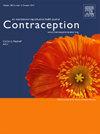多布斯决定后女性永久性避孕频率和决策的变化
IF 2.3
2区 医学
Q1 OBSTETRICS & GYNECOLOGY
引用次数: 0
摘要
方法 我们对在纽约州和宾夕法尼亚州接受间歇性永久避孕手术的患者进行了一项回顾性队列研究,比较了多布斯案之前(7/1/2020-6/30/2022)和多布斯案之后(7/1/2022-6/30/2023)的队列。主要结果是手术量的变化;次要结果包括患者特征的差异。我们从 2022 年夏季开始实施标准化决策文档,从而可以评估后多布斯队列中患者的考虑因素。我们在 Stata SE 中进行了学生 t 检验、卡方检验和描述性统计。结果多布斯手术前有 429 例,多布斯手术后有 310 例,其中纽约州有 194 例(26.3%),宾夕法尼亚州有 545 例(73.7%)。两家机构的手术量都有大幅增长,从平均每月 8.9 例增加到 12.9 例(P=0.009)。多布斯手术后的患者多在30岁以下(31.7%对39.0%,p=0.039)和无子宫(10.7%对21.0%,p<0.001)。96名患者的决策文件记录显示,两地患者的决策情况相似,20%的患者考虑将来采取永久性避孕措施,18%的患者考虑将来采取可逆性避孕措施,23%的患者考虑将来采取人工流产措施。在这两个地点,47% 的患者表示他们的决定与当前的政治事件有一定或非常大的关系。对失去未来生育选择权的恐惧被纳入了生育决策中,这说明了政治威胁对患者自主权的广泛影响。本文章由计算机程序翻译,如有差异,请以英文原文为准。
CHANGES IN FREQUENCY AND DECISION-MAKING FOR FEMALE PERMANENT CONTRACEPTION FOLLOWING THE DOBBS DECISION
Objectives
We aimed to compare the frequency of female permanent contraceptive procedures before and after the Dobbs v Jackson Women’s Health Organization decision, and to assess impact of political factors on patient decision-making.
Methods
We conducted a retrospective cohort study of patients who underwent interval permanent contraceptive procedures in New York and Pennsylvania, comparing a pre-Dobbs (7/1/2020-6/30/2022) and post-Dobbs cohort (7/1/2022-6/30/2023). The primary outcome was change in procedure volume; secondary outcomes included differences in patient characteristics. We implemented standardized decision-making documentation beginning summer 2022, which allowed assessment of patient considerations in the post-Dobbs cohort. We performed Student t-tests, chi square tests, and descriptive statistics in Stata SE.
Results
There were 429 procedures pre-Dobbs and 310 post-Dobbs, including 194 (26.3%) procedures in New York and 545 (73.7%) in Pennsylvania. Volume grew significantly at both institutions, together increasing from an average 8.9 to 12.9 procedures/month (p=0.009). Patients post-Dobbs were more often under age 30 (31.7% vs. 39.0%, p=0.039) and nulliparous (10.7% vs. 21.0%, p<0.001). Decision-making documentation was recorded for 96 patients and was similar between sites, with 20% of patients considering future access to permanent contraception, 18% considering future access to reversible contraception, and 23% considering future access to abortion. At both sites, 47% of patients said their decision was somewhat or very related to current political events.
Conclusions
In two states without new abortion restrictions, permanent contraception was sought by more patients post-Dobbs, particularly younger and nulliparous patients. Fear of losing access to future reproductive options is integrated into reproductive decision-making, illustrating the wide-reaching impact of political threats to patient autonomy.
求助全文
通过发布文献求助,成功后即可免费获取论文全文。
去求助
来源期刊

Contraception
医学-妇产科学
CiteScore
4.70
自引率
17.20%
发文量
211
审稿时长
69 days
期刊介绍:
Contraception has an open access mirror journal Contraception: X, sharing the same aims and scope, editorial team, submission system and rigorous peer review.
The journal Contraception wishes to advance reproductive health through the rapid publication of the best and most interesting new scholarship regarding contraception and related fields such as abortion. The journal welcomes manuscripts from investigators working in the laboratory, clinical and social sciences, as well as public health and health professions education.
 求助内容:
求助内容: 应助结果提醒方式:
应助结果提醒方式:


